Class 11 Biology Chapter 19 Important Questions - Excretory Products and their Elimination
Biology is one of the most essential conceptual-based subjects of science. Class 11 and 12 Biology forms the base for students who wish to pursue their careers in medicine. Other future career options for Biology students include research, pharmacovigilance, biotech, and much more. To make a robust career in these fields, good conceptual knowledge of Biology is mandatory.
There are 22 chapters in the CBSE Biology Class 11 textbook including Mineral Nutrition, Cell Cycle, Anatomy, Digestion, and so on.
Class 11 Biology Chapter 19 is about ‘Excretory products and their elimination. The topic is practical and requires a thorough understanding of the mechanisms involved. It may be difficult for students to understand the subject initially, but with the availability of proper study materials, it is possible to score good marks in the exam.
Extramarks is a topmost online education platform helping students from Class 1 to Class 12 studies. Students can confidently rely on our comprehensive study materials including NCERT solutions, chapter notes, CBSE revision notes, solved past question papers, etc.
Extramarks understands the importance of regularly practising questions for Biology, Chemistry and Physics for students to get a good understanding of the subject. Our experienced Biology subject experts have prepared a question bank of Important Questions Class 11 Biology Chapter 19 by keeping in mind the difficulties which every student faces while studying tough Biology topics such as the excretory system. The questions and answers are prepared according to the CBSE syllabus so students can find a comprehensive set of questions in one place. The students are advised to go through the Important Questions Class 11 Science Biology Chapter 19 to ensure thorough preparation not only from an academic perspective but also from the point of view of the competitive exams.
Students may register on Extramarks website to get access to our question bank of Class 11 Biology Chapter 19 Important Questions.
Access Excretory Products and their Elimination Important Questions & Answers for the Academic Year 2022-23.
Class 11 Biology Chapter-wise important questions are available for free to students, and these questions are perfect for self-study.
Check out CBSE Class 11 Biology Important Questions for other chapters as well:
Important Questions of Excretory Products and their Elimination With Solutions
The answers given in our question bank of Chapter 19 Class 11 Biology Important Questions not only cover explanations but also cover important diagrams and flowcharts, which encourages students to understand the topic fully. By solving the questions students are able to revise the chapter and it will help them score high marks in exams.
Given below is a list of some questions and answers from our question set of Important Questions Class 11 Biology Chapter 19.
Question 1. Explain the micturition and disorders of the excretory system briefly.
Answer 1. The micturition is also called urination. It is a spinal reflex that the higher voluntary centres regulate in the brain. During this process, the smooth muscles of the urinary bladder contract and the sphincter of the urethra relaxes to avoid the urine.
The disorders of the excretory system are:
- Polyuria is the formation of more than an average amount of urine.
- Oliguria is the formation of less urine.
- Anuria means no urine formation.
- Phenylketonuria is a genetic autosomal recessive disorder characterised by the presence of phenyl ketone bodies in urine.
- Alkaptonuria is a condition characterised by the presence of alkapton bodies in urine, and the urine turns black on exposure.
- Albuminuria is the presence of albumin protein in the urine.
- Haematuria is the presence of blood in the urine.
- Cystinuria is the presence of cysteine in urine due to an error in metabolism.
- Uremia is a condition in which excessive urea is present in the blood. It may lead to kidney failure.
- Renal failure is the inability of kidneys to carry out excretory and salt-water regulatory mechanisms.
- Renal calculi are the stone formation within the kidney.
- Glomerulonephritis is the inflammation of the glomeruli of the kidneys.
- Diabetes insipidus is a condition characterised by frequent micturition.
Question 2. Comment upon the hormonal regulation of selective reabsorption.
Answer 2. Selective reabsorption is the second step of urine formation.
- Antidiuretic hormone (ADH) or vasopressin aids in the absorption of water from glomerular filtrate in the uriniferous tubules of the kidney. This hormone is responsible for reducing water in the urine and concentrating it. Hyposecretion of this hormone causes a condition called diuresis or diluted urine, in which the amount of water is increased in urine.
- Atrial Natriuretic factor (ANF) is secreted by the atria of heart and is a vasodilator. It increases sodium excretion and works antagonistically to the renin-angiotensin mechanism. It inhibits the reabsorption of sodium and chloride ions in DCT and increases urine concentration. It reduces aldosterone release from the adrenal gland.
- Angiotensin II is a potent vasoconstrictor that regulates GFR by increasing glomerular blood pressure. It also stimulates the absorption of sodium by proximal tubules. It also activates the adrenal cortex to secrete aldosterone, which is responsible for sodium and water absorption from the distal convoluted tubule.
Question 3 . Describe the structure of the human kidney with a labelled diagram
Answer 3.
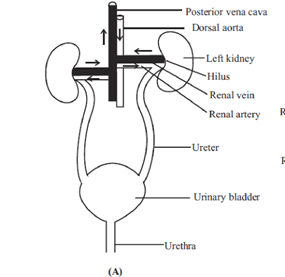
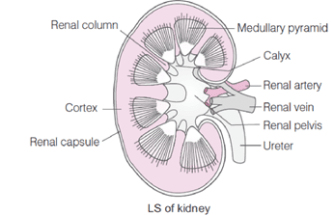
Kidneys are mesodermal in origin. The human kidney is retroperitoneal means it is located outside the coelomic cavity and is covered by the peritoneum from the ventral side only. The kidneys are located below the diaphragm. The right kidney is lower and smaller than the left kidney because the liver is on the right side and takes up much space.
Each kidney is bean-shaped, with a groove called hilus in the middle.
The external structure of the kidney: The outer surface is convex, and the inner concave surface has a notch known as the hilum. The blood supply occurs through the hilum means the renal artery and renal vein pass in and out of the kidneys along with the ureter and nerve supply of the kidney.
From outside to inside, the kidney has three layers which protect the kidney from external injuries. They are:
- Renal fascia.
- The adipose layer.
- The renal capsule is the innermost layer.
The internal structure of kidney:
The kidney has two regions: outer cortex and the inner medulla. The ureter expands in a funnel-shaped cavity called the pelvis. The free end of the pelvis has cup-like cavities called the calyx. They can be major calyx and minor calyx. The medulla projects into the calyx as conical projections called renal or medullary pyramids. These can be 4-24 in number. The tip of the pyramid is called renal papillae, and the cortex between medullary pyramids is called the columns of Bertini.

The microscopic structure of kidneys:
The nephron is the structural and functional unit of the kidney. In humans, there are two types of nephrons, namely cortical and juxtamedullary nephrons.
Cortical nephrons constitute 85 % of the nephrons. The glomeruli are present in the outer cortex, and Henle’s loop is shorter. Vasa recta is absent in this type of neuron.
Juxtamedullary nephrons constitute 15 % ,and the glomeruli are present in the inner cortex. The Henle’s loop, is longer and the vasa recta is well developed.
Each nephron has the following parts:
- Bowman’s capsule
- Proximal convoluted tubule (PCT)
- Henle’s loop
- Distal convoluted tubule(DCT)
- Collecting tubule
Bowman’s capsule is a double-walled structure with inner layer of modified squamous epithelial cells called the podocyte layer. The capsule includes a bunch of capillaries ranging from 20-40 in a number called the glomerulus. They are arterial in nature and have more permeability due to the presence of fenestrae. These capillaries arise from afferent arteriole and join to form efferent arteriole. The glomerulus, along with Bowman’s capsule, is called the Malpighian body.
PCT lined by brush border epithelium increases surface area for absorption.
Henle’s loop has descending and ascending limbs. The descending limb is lined by flat cells, permeable to water and impermeable to sodium chloride. Ascending limb is lined by cuboidal cells permeable to sodium and impermeable to water.
DCT does not have well-developed microvilli and is lined by cuboidal epithelium.
Question 4. Differentiate Glycosuria from ketonuria.
Answer 4. Glycosuria means the presence of glucose in urine. It is seen in diabetes and Cushing syndrome.
Ketonuria is the presence of ketone bodies in urine. It is seen in diabetes.
Question 5. What are the main processes of urine formation?
Answer 5. The process of urine formation is known as uropoiesis. The process involves three steps:
- Glomerular filtration: The filtration of blood is carried out by the glomerulus. This is why this step is known as glomerular filtration. The blood rushes into the glomerular capillaries with high pressure and gets filtered across the thin walls of the capillaries. The glomerular filtrate is plasma minus proteins and consists of glucose, amino acids, water, urea, uric acid, hippuric acid, salts, vitamins, creatinine, bicarbonates, phosphates, etc.
- Selective reabsorption: This step involves the formation of urine with the filtrate. The process is called reabsorption. In PCT, the maximum reabsorption from glomerular filtrate takes place. Glucose and amino acids are absorbed 100 % by active transportation and do not appear in the urine in normal conditions. Active transportation requires energy in the form of ATP and is against the concentration gradient. Urea and uric acid are not completely reabsorbed and appear in urine under normal conditions. Creatinine and sulphates are not at all absorbed in this step. The absorption of chloride is passive. The counter-current mechanism makes the fluid more concentrated in Henle’s Loop. The absorption of sodium occurs in ascending loop only. The water absorption in DCT and collecting tubule and collecting duct is ADH dependent.
The water absorption is 60 – 70 % in PCT, 15 % in Henle’s loop and 4-5 % in DCT.
- Tubular secretion: It is an essential step in urine formation. Certain chemicals in the blood which are not removed from the glomerular capillaries are removed in this step. There is the maintenance of ionic and acid-base balance by the removal of ions and other molecules which are toxic at elevated levels. The maximum tubular secretion is added from PCT and DCT linings. It includes the addition of creatinine, ammonia, hydrogen ions, potassium ions and uric acid into the glomerular filtrate.
Question 6. Show the structure of renal corpuscles with the help of a diagram.
Answer 6. Renal corpuscles constitute Glomerulus and Bowman’s capsule. It filters large solutes from blood and delivers small solutes to the renal tubule for modification. It is also known as the Malpighian body.
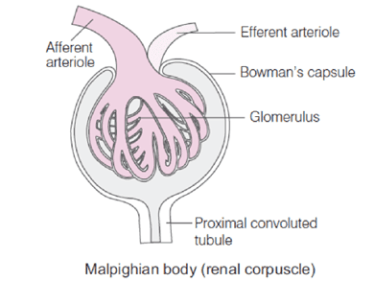
Question 7. Where does the selective reabsorption of Glomerular filtrate take place?
Answer 7. The selective reabsorption of glomerular filtrate occurs in Proximal Convoluted Tubule and Distal Convoluted Tubule. In PCT, all essential nutrients are absorbed and in DCT, the facultative reabsorption of sodium and water occurs.
Question 8. What is the role of sebaceous glands?
Answer 8. Sebaceous glands secrete sebum which eliminates sterols, fatty acids, waxes and hydrocarbons.
Question 9. Why is a haemodialysis unit called an artificial kidney?
Answer 9. Haemodialysis removes urea and creatinine. The blood of a person is filtered in a haemodialysis unit in which dialysing fluid is present, which has the same composition as plasma and lacks nitrogenous waste.
Question 10. Draw a labelled diagram showing the reabsorption and secretion of major substances at different parts of the nephron.
Answer 10.

Question 11. How have terrestrial organisms adapted themselves for the conservation of water?
Answer 11. Terrestrial adaptation requires the production of less toxic nitrogenous waste like urea and uric acid to conserve water. Ammonia excreted by aquatic animals requires a large amount of water to dissolve. But for terrestrial animals, such a huge amount of water is unnecessary. They need less water for excretion and are either ureotelic or uricotelic.
Question 12. What is the excretory structure in amoeba?
Answer 12: The contractile vacuole is the excretory organ in amoeba, which is responsible for excretion and osmoregulation. Ammonia is the main nitrogenous waste in amoeba.
Question 13. What is meant by osmoregulation?
Answer 13. Osmoregulation is the phenomenon of regulation of change in the concentration of body fluid according to the concentration of the external environment. The kidneys are guardians of the internal environment. By regulating the urine production from the blood, the nephrons carry excretion and osmoregulation both. The two types of neurons and Henle’s loop length play a significant role in osmoregulation. When the water supply is normal to excessive, cortical neurons function; juxtamedullary nephrons function when the water supply is short.
Question 14. What is the significance of the juxtaglomerular apparatus in kidney function?
Answer 14. The juxtaglomerular apparatus has a significant effect on kidney function.
- Hormones are essential signalling molecules which control water regulation through the kidneys. The kidney function is regulated by a hormonal feedback mechanism which involves the hypothalamus, the juxtaglomerular apparatus and the heart.
- The cells of the juxtaglomerular apparatus release the enzyme renin and play an important role in the renin-angiotensin mechanism.
- The juxtaglomerular apparatus carries out the autoregulatory mechanism of GFR.
Question 15. Give a brief account of the countercurrent mechanism.
Answer 15. The countercurrent mechanism is a special mechanism which can absorb more water from the glomerular filtrate for water conservation. This mechanism makes urine more concentrated. The mechanism includes:
- Henle’s loop and the vasa recta play an essential role in this mechanism. Counter current means the flow of filtrate in the limbs of Loop of Henle is in the opposite direction. This same pattern is followed in vasa recta also.
- The osmolarity of the interstitium of the renal medulla is hypertonic. This gradient is from the renal cortex to the tip of the medullary papillae.
- The high osmolarity is due to the active transport of sodium and, potassium, chloride ions from the thick ascending loop of Henle into the interstitium.
- The hyperosmolarity at the tip of papillae is high as 1200-1450 mOsmolL.This indicates that the medullary interstitium has more solute accumulated in water excess.
- This gradient is maintained by the counter-current mechanism and the proximity between Henle’s loop and vasa recta. There is a balanced inflow and outflow of solutes and water.
- The movement of NaCl and urea maintain the gradient. The transport of these substances is arranged by the loop of Henle and vasa recta. Vasa recta is a capillary network around an individual limb of the loop of Henle and acts as a countercurrent exchanger.
- Ascending limb is impermeable to water, and the descending limb of Henle’s loop is highly permeable to water. These differences in permeability establish a gradient.
- The mechanism has two aspects - countercurrent multiplication by the Henle’s Loop and the countercurrent exchange by the vasa recta.
- In countercurrent multiplication, there is repetitive reabsorption of sodium from the thick ascending limb of Loop of Henle and continuous inflow of new sodium chloride from PCT.
- NaCl is transported by the ascending limb of Henle’s loop. These enter the descending limb of the vasa recta.
- NaCl returns to the medullary interstitium by the ascending part of the vasa recta. The water diffuses into the blood of the ascending limb of the vasa recta and is carried away in general circulation.
- The deeper parts of the thin ascending limb of Henle’s loop and collecting duct have permeability to urea.
- Urea, after diffusing out of the collecting ducts, enters into the thin ascending limb.
- Urea is recycled and trapped in the medullary interstitium by the collecting tubule.
- In this way the mechanism maintains a concentration gradient in the medullary interstitium.
- Due to this mechanism, the urine is concentrated four times more than the initial filtrate formed.
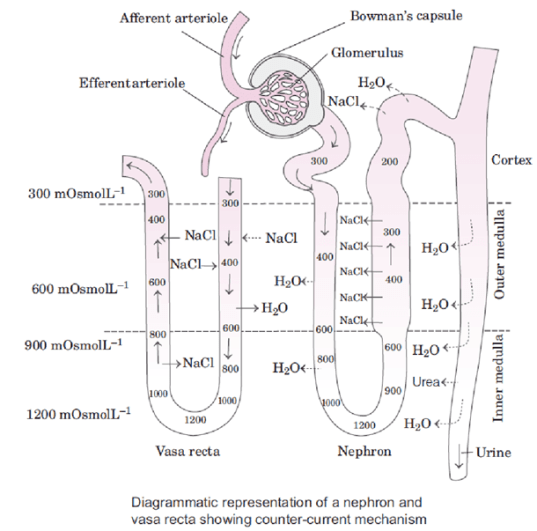
Question 16. Describe the role of lungs, liver and skin in excretion.
Answer 16. Water and carbon dioxide are the waste products of respiration, and they are removed by the lungs. Human lungs eliminate 18 L of carbon dioxide per hour and 400 ml of water daily.
The liver converts decomposed haemoglobin into bile pigments, namely, bilirubin and biliverdin, which are the excretory products in bile. The bilirubin is broken down into stercobilin and urobilin. Bilirubin is a toxic substance, and its accumulation in the body produces jaundice. These pigments are eliminated in faces. Besides this, cholesterol, steroid hormones, vitamins and certain drugs are excreted by the liver via bile. The liver eliminates unwanted amino acids which produce ammonia. This ammonia combines with carbon dioxide and forms urea. This is the urea cycle or Ornithine cycle. The kidneys eliminate this urea.
The skin has sweat and sebaceous glands. Sweat glands secrete sweat, and sebaceous glands produce sebum.
Question 17. Mention any two metabolic disorders which can be diagnosed by analysis of urine.
Answer 17. Diabetes mellitus and cystinuria can be diagnosed by urine analysis.
Question 18. Identify the glands that perform the excretory functions in prawns.
Answer 18. Green glands perform the excretory function in prawns. They are also called antennal glands because they are seated at the base of the antenna. This excretory system contains coelomic, labyrinth, nephridial duct, bladder and nephridiopore.
Question 19. What is the composition of sweat produced by the sweat glands?
Answer 19. The sweat contains sodium chloride, lactic acid, a small amount of urea, amino acids and glucose.
Question 20. What is the role played by Renin-Angiotensin in the regulation of kidney function?
Answer 20. The role played by the renin-angiotensin system is given below:
- The walls of the afferent arteriole contain the renin-secreting juxtaglomerular cells.
- The cells of the juxta-glomerular apparatus release the enzyme renin when the blood pressure is low. This enzyme converts Angiotensinogen in blood to Angiotensin-I and Angiotensin-II.
- Angiotensinogen is a protein of blood plasma which is produced by the liver.
- Angiotensin raises blood pressure by constricting blood vessels since it is a powerful vasoconstrictor.
- Angiotensin raises Glomerular Filtrate Rate (GFR).
- This system activates the adrenal cortex to release aldosterone.
- Aldosterone facilitates the reabsorption of sodium and water from the distal parts of the tubule. This raises blood pressure and GFR.
- This is autoregulation of the Glomerular Filtration Rate.
Question 21. Explain the autoregulatory mechanism of GFR.
Answer 21: The autoregulatory mechanism by which the kidneys regulate the juxtaglomerular apparatus to carry out GFR. This apparatus is present between the vascular pole of a renal corpuscle and the returning DCT. This apparatus performs two important functions, one being regulation of renal flow and the second being GFR.
When the GFR declines, the juxtaglomerular cells activate and release renin which stimulates the glomerular blood flow and brings GFR back to normal.
Question 22. Give the name of two actively transported substances in glomerular filtration.
Answer 22: Amino acids and glucose are the two substances actively transported in glomerular filtration.
Question 23. Indicate whether the following statements are true or false
- ADH helps in water elimination making the urine hypotonic.
- Protein-free fluid is filtered from blood plasma into the Bowman’s capsule.
- Henle's loop plays an important role in concentrating urine.
- Glucose is actively reabsorbed in the proximal convoluted tubule.
Answer 23:
- False. This is because ADH help in increasing the reabsorption of water.
Question 24. Is there any difference between rennin and renin? Explain
Answer 24. Rennin is a protein-digesting enzyme secreted by gastric glands of the stomach. Renin is secreted by the juxtaglomerular cells of the kidney.
Question 25. Name the excretory products of reptiles and prawns.
Answer 25: uric acid is excreted by reptiles and ammonia by prawns.
Question 26. Multiple choice questions:
- Urine is stored in which part of the excretory system?
Answer 26
- : c) urinary bladder
Explanation: Urinary bladder temporarily stores urine.
- Which portion of the nephron is impermeable to water?
Answer: b) Ascending limb of Henle.
Explanation: The ascending limb of Henle is impermeable to water. It allows the active or passive transfer of electrolytes.
- The human urine is usually acidic because
- The exchange of sodium and potassium generates acidity.
- Plasma proteins excreted are acidic
- Active secretion of hydrogen ions makes the urine acidic.
- The sodium transporter exchanges one hydrogen ion for each sodium ion in peritubular capillaries.
Answer :c) Active secretion of hydrogen ions makes the urine acidic.
Explanation: High concentrations of hydrogen ions make urine acidic as the pH of the filtrate decreases.
Answer: b) 6
Explanation : The urine is slightly acidic.
Question 27. Which hormone is responsible for controlling the sodium concentration in the body?
Answer 27. Aldosterone regulates sodium concentration in the body with increased permeability of walls of DCT for sodium ions.
Question 28. Name the excretory organs in cockroaches.
Answer 28. The excretory organ of cockroaches is the malpighian tubules.
Question 29. Explain podocytes.
Answer 29. They are the epithelial cells of Bowman’s capsule. The inner visceral wall of the glomerulus is composed of a special type of cells which are less flattened and is called podocytes. The filtration slits or slit pores are very minute spaces which are present between the podocytes.
Question 30. What is glomerulonephritis?
Answer 30. It is defined as the inflammation of the glomeruli of the kidneys.
Question 31. Explain the types of nitrogen excretion.
Answer 31: The three types of nitrogen excretion are ammonotelism, ureotelism and uricotelism.
Ammonotelism is the excretion of ammonia by the process of diffusion across the surface of the body. Such organisms require a large amount of water due to high toxicity, and kidneys are not involved in this process.
Ureotelism means ammonia is converted to urea by the liver. This urea is excreted by the kidneys. Urea is relatively less toxic and is less soluble in water. Urea is retained in a small amount to maintain osmolarity.
Uricotelism means uric acid is excreted in the form of a pellet. There is minimum loss of water. Uric acid is insoluble in water and is relatively non-toxic.
Question 32. What are the functions of the kidney?
Answer 32: The functions of the kidney are:
- Removal of metabolic waste from the body.
- Maintenance of water and electrolyte balance.
- Hormonal secretory function like renin secretion.
- Regulation of arterial pressure.
Question 33. What is the composition of urine?
Answer 33. The composition of urine is 95 % water, 2 % salt, 2.6 % urea, 0.3 % uric acid and traces of ammonia,creatinine,etc.
Question 34. Why is urine yellow in colour?
Answer 34: Urine is yellow in colour due to the presence of pigment urochrome which is produced by the breakdown of haemoglobin.
Question 35. What is the urea cycle?
Answer 35: The urea cycle is also known as Krebs – Henseleit or Ornithine cycle. Urea is produced in the liver with the help of an essential enzyme called Arginase. The three important amino acids involved in the urea cycle are Arginine, Ornithine and Citrulline.
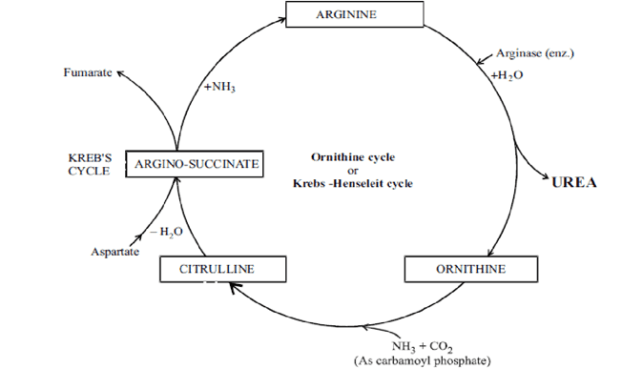
Benefits of Solving Class 11 Biology Chapter 19 Important Questions
Students get the added advantage of interactive learning by registering on the Extramarks website. The chapter notes come with detailed step-by-step explanations along with diagrams and flowcharts, which help the students clear all their doubts and strengthen their base.
Following are some of the benefits of studying from our question bank of Important Questions Class 11 Biology Chapter 19:
- The question bank has detailed solutions to all the questions in the textbook. There will be a few tricky questions between chapters that make students think literally and apply the concepts learned in the chapter. Multiple choice questions have a significant weightage in final examinations and require a lot of critical thinking to solve the questions. Extramarks provides a complete list of chapter-wise multiple-choice questions to help students prepare effectively for their examinations.
- The answers to all questions are prepared based on the latest NCERT books and CBSE guidelines and syllabus. Difficult topics are explained with diagrams, cycles and flowcharts followed by a step-by-step explanation which makes it easy for students to broaden their knowledge.
- The questions are collated by referring to various trusted sources, including NCERT textbooks, NCERT exemplar books, past years' question papers, and other sources. The study material designed by our subject matter experts will definitely meet the students' requirements..
- Therefore, it is necessary to take guided practice and help to be aware of the mistakes and maximise your potential by learning how to frame the right answer and develop confidence. Our main motive is to make learning organised, exam-oriented and conceptually strong from the examination point of view for the students.
To get maximum benefit, students are suggested to practise these questions rigorously from our Important Questions Class 11 Biology Chapter 19.
Extramarks believes in incorporating joyful learning experiences through its own repository of resources. Furthermore, students can access the other study materials from Classes 1 to 12 by clicking on the below links: